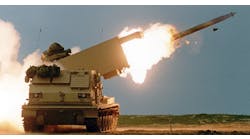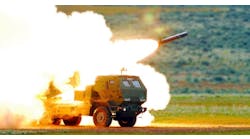The federal Defense Advanced Research Projects Agency (DARPA) placed a contract with Lockheed Martin to develop and demonstrate a nuclear-powered spacecraft – for space exploration as well as defense. The value of the award was not announced, but it calls for Lockheed to conduct an in-space flight demonstration of a nuclear-thermal rocket engine vehicle by 2027.
The project – called Demonstration Rocket for Agile Cislunar Operations (DRACO) – was initially announced in January as a partnership of DARPA and NASA's Space Technology Mission Directorate.
As explained by Lockheed, nuclear thermal propulsion (NTP) engines provide “thrust” that is comparable to conventional chemical propulsion rocket engines, but with two-to-five times higher efficiency. That indicates a spacecraft can travel faster and farther, with lower propellant (fuel) requirements.
Nuclear thermal propulsion (NTP) engines offer thrust as high as conventional chemical propulsion with two-to-five times higher efficiency, which means the spacecraft can travel faster and farther and can significantly reduce propellant needs. They also enable abort scenarios on journeys to Mars that are not possible with chemical propulsion systems.
In an NTP system, a nuclear reactor quickly heats a hydrogen propellant and delivers that gas through the engine nozzle to create thrust. Lockheed is partnered with BWX Technologies to develop a fission-based reactor using a special “high-assay low-enriched uranium (HALEU)” to convert cryogenic hydrogen into an extremely hot pressurized gas.
The reactor will not be turned on until the spacecraft has reached “a nuclear safe orbit,” Lockheed emphasized, so that an NTP system remains a safe propulsion technology.
"These more powerful and efficient nuclear thermal propulsion systems can provide faster transit times between destinations. Reducing transit time is vital for human missions to Mars to limit a crew's exposure to radiation," said Kirk Shireman, vice president of Lunar Exploration Campaigns at Lockheed Martin Space. "This is a prime technology that can be used to transport humans and materials to the Moon. A safe, reusable nuclear tug spacecraft would revolutionize cislunar operations. With more speed, agility and maneuverability, nuclear thermal propulsion also has many national security applications for cislunar space."
Lockheed also noted that an NTP would allow “abort scenarios” on long-distance space journeys (i.e., Earth to Mars) that would not be possible with chemical propulsion systems.
"These more powerful and efficient nuclear thermal propulsion systems can provide faster transit times between destinations. Reducing transit time is vital for human missions to Mars to limit a crew's exposure to radiation," stated Kirk Shireman, v.p. of Lunar Exploration Campaigns at Lockheed Martin Space. "This is a prime technology that can be used to transport humans and materials to the Moon. A safe, reusable nuclear tug spacecraft would revolutionize cislunar operations. With more speed, agility and maneuverability, nuclear thermal propulsion also has many national security applications for cislunar space."






